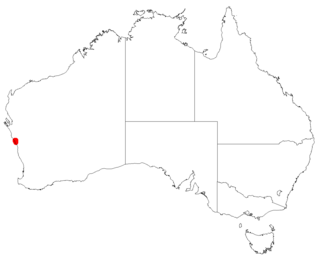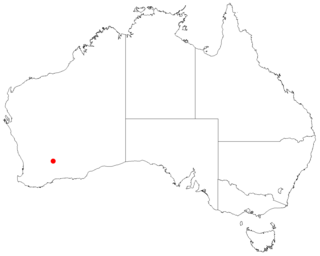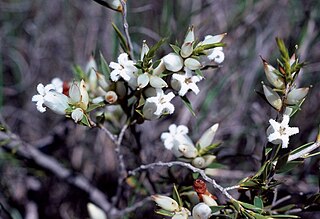
Leucopogon obovatus is a species of flowering plant in the heath family Ericaceae and is endemic to the southwest of Western Australia. It is an erect shrub with hairy young branchlets, variably-shaped, simple leaves, and erect clusters of 3 to 15 white, bell-shaped flowers on the ends of branches and in upper leaf axils.

Styphelia stomarrhena is a species of flowering plant in the family Ericaceae and is endemic to the south-west of Western Australia. It is a low, spreading or compact shrub with narrowly elliptic, sharply-pointed leaves and red, tube-shaped flowers usually arranged singly in leaf axils.

Leucopogon borealis is a species of flowering plant in the heath family Ericaceae and is endemic to a restricted area of the west of Western Australia. It is an erect shrub with hairy young branchlets, linear leaves and white flowers in nine to twenty upper leaf axils.

Leucopogon validus is a species of flowering plant in the heath family Ericaceae and is endemic to a restricted part of the south-west of Western Australia. It is a robust shrub with glabrous branchlets, narrowly elliptic leaves and white, bell-shaped flowers arranged in six to twelve upper leaf axils and on the ends of branches.

Styphelia capillaris, commonly known as Horts' styphelia, is a species of flowering plant in the heath family Ericaceae and is endemic to a small area of south-western Western Australia. It is a dense, spreading shrub with narrowly egg-shaped to narrowly elliptic leaves and white flowers arranged singly or in pairs in leaf axils.
Styphelia angustiflora is a species of flowering plant in the heath family Ericaceae and is endemic to a small area near York, in the south-west of Western Australia. It is an erect, compact shrub with sharply-pointed, narrowly egg-shaped leaves and white, tube-shaped flowers.
Styphelia cernua is a species of flowering plant in the heath family Ericaceae and is endemic to a small area of Western Australia. It is an erect shrub with narrowly egg-shaped leaves with the narrower end towards the base, and white flowers arranged singly or in pairs in leaf axils.
Styphelia chlorantha is a species of flowering plant in the heath family Ericaceae and is endemic to a small area of Western Australia. It is a low, spreading shrub with erect, narrowly egg-shaped to egg-shaped leaves with the narrower end towards the base, and green, tube-shaped flowers arranged singly in leaf axils.

Styphelia acervata is a species of flowering plant in the heath family Ericaceae and is endemic to the south-west of Western Australia. It is a dense, prostrate, mat-forming shrub with erect, narrowly egg-shaped leaves, and cream-coloured and greenish tube-shaped flowers.
Brachyloma pirara is a species of flowering plant in the family Ericaceae and is endemic a restricted area in the west of Western Australia. It is an erect, compact shrub with sharply-pointed, linear to narrowly egg-shaped or narrowly elliptic leaves, and red, tube-shaped flowers.
Styphelia disjuncta is a species of flowering plant in the heath family Ericaceae and is endemic to a small area in the south-west of Western Australia. It is an erect shrub with egg-shaped to narrowly egg-shaped leaves, and white, tube-shaped flowers arranged singly in leaf axils.
Styphelia filamentosa is a species of flowering plant in the heath family Ericaceae and is endemic to a small area in the south-west of Western Australia. It is a low, compact, spreading shrub with egg-shaped to narrowly elliptic leaves, and white, tube-shaped flowers arranged singly, or in groups of up to four in leaf axils.
Styphelia filifolia is a species of flowering plant in the heath family Ericaceae and is endemic to the south-west of Western Australia. It is an erect shrub with erect, linear leaves, and white, tube-shaped flowers arranged singly, or in groups of up to four in leaf axils.
Styphelia longissima is a species of flowering plant in the heath family Ericaceae and is endemic to a few places in the south-west of Western Australia. It is an erect shrub with hairy young branchlets, stem-clasping, sharply-pointed, narrowly egg-shaped to narrowly elliptic leaves, and white, tube-shaped flowers.
Styphelia oblongifolia is a species of flowering plant in the heath family Ericaceae and is endemic to the south-west of Western Australia. It is an open or straggling shrub with erect, narrowly oblong leaves and pale yellow, tube-shaped flowers.
Styphelia quartzitica is a species of flowering plant in the heath family Ericaceae and is endemic to a small area in the south of Western Australia. It is an erect shrub with hairy young branchlets, sharply-pointed, linear or very narrowly egg-shaped leaves, and cream-coloured, tube-shaped flowers.
Styphelia rectiloba is a species of flowering plant in the heath family Ericaceae and is endemic to a small area in the south of Western Australia. It is a spreading, compact shrub with hairy young branchlets, sharply-pointed egg-shaped leaves, and cream-coloured, tube-shaped flowers.
Styphelia sulcata is a species of flowering plant in the heath family Ericaceae and is endemic to a small area in the south of Western Australia. It is a low, compact shrub with narrowly egg-shaped leaves and white flowers arranged singly in leaf axils.

Styphelia xerophylla is a species of flowering plant in the heath family Ericaceae and is endemic to the south-west of Western Australia. It is an erect, compact shrub with egg-shaped to narrowly egg-shaped leaves and white, tube-shaped flowers with hairy lobes.

Styphelia williamsiorum is a species of flowering plant in the heath family Ericaceae and is endemic to a small area in the south-west of Western Australia. It is a low, compact shrub with decussate, narrowly egg-shaped leaves, and deep purple, tube-shaped flowers with hairy lobes.








